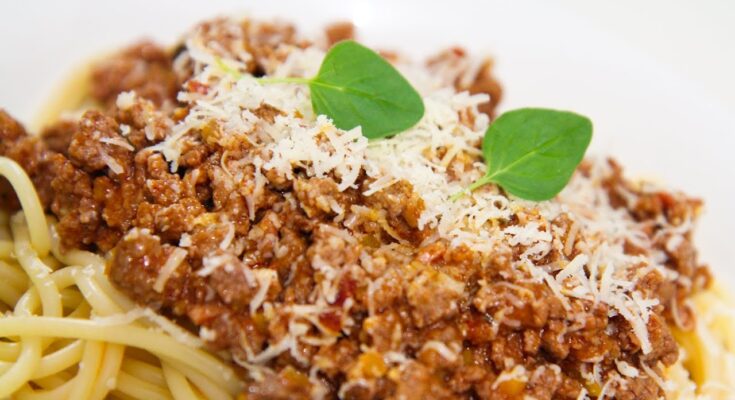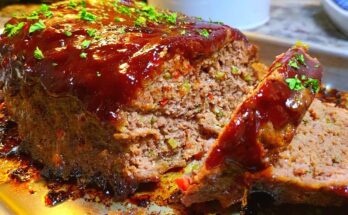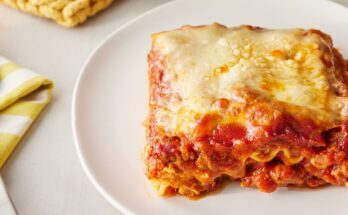Bolognese Sauce Recipe: Few things in the culinary world are as comforting as a warm bowl of pasta topped with rich, savory Bolognese sauce. Originating from Italy, this sauce combines hearty meat, slow-cooked vegetables, and rich tomato flavors in perfect harmony.
Follow this step-by-step guide to create an authentic Bolognese sauce that will have your guests asking for seconds.
History and Origin of Bolognese Sauce
Bolognese sauce, or “ragù alla Bolognese,” hails from Bologna, Italy. Traditional Italian versions are often thicker and rely more on meat than tomatoes, differing significantly from the tomato-heavy versions popular in other countries. Over the years, chefs have adapted the recipe to suit their tastes, but the core technique of slow simmering remains the key to achieving the sauce’s signature depth of flavor.
Ingredients for Bolognese Sauce Recipe
To make an authentic Bolognese sauce, you’ll need the following ingredients:
- Ground beef and/or pork
- Carrots, celery, and onions (for the soffritto base)
- Crushed tomatoes or canned tomato puree
- White or red wine
- Milk or cream
- Olive oil and/or butter
- Garlic, bay leaves, and fresh herbs
Each ingredient plays a vital role in creating the balance of flavors. The meat provides heartiness, while the vegetables and wine add complexity and sweetness. Slow-cooked tomatoes give it richness, while the final touch of milk adds a silky texture.
Essential Tools and Equipment
Before you begin, make sure you have the right tools for the job:
- Large, heavy-bottomed pot (like a Dutch oven)
- Wooden spoon for stirring
- Sharp knife and cutting board for prepping ingredients
- Measuring cups and spoons for accuracy
A heavy pot helps retain and evenly distribute heat, ensuring your sauce cooks slowly without burning.
Preparing for the Recipe
Success in the kitchen often comes down to preparation. Start by organizing your ingredients and tools. Chop your vegetables, measure out your liquids, and lay everything within arm’s reach. This “mise en place” method saves you time and helps prevent mistakes.
Step 1: Preparing the Base Flavors (Soffritto)
The secret to a flavorful Bolognese sauce is starting with a soffritto—a blend of finely chopped onions, carrots, and celery.
- Heat olive oil and butter in your pot over medium heat.
- Add the chopped vegetables and cook for about 10 minutes, stirring occasionally.
- Cook until softened but not browned. The goal is to extract their natural sweetness, which forms the flavor foundation for the sauce.
This step shouldn’t be rushed, as it sets the stage for the deep, complex taste you want to achieve.
Step 2: Adding and Browning the Meat
Once your soffritto is ready, it’s time to add the meat.
- Increase the heat to medium-high and add ground beef and/or pork.
- Break the meat apart with a wooden spoon and brown it thoroughly.
- Season with salt and pepper as it cooks.
Browning the meat is crucial. It develops what’s called the Maillard reaction, where the proteins and sugars in the meat caramelize, adding depth and umami.
Step 3: Deglazing with Wine
Now it’s time to deglaze the pot, which means loosening the flavorful browned bits stuck to the bottom.
- Pour in half a cup of wine (red for a robust flavor, white for a lighter touch).
- Scrape the bottom of the pot to release the browned bits.
- Allow the wine to reduce by half, concentrating its flavor.
Deglazing adds acidity and richness, balancing the sauce’s meatiness.
Step 4: Adding Tomatoes and Seasoning
After deglazing, it’s time to incorporate tomatoes.
- Add crushed tomatoes or tomato puree to the pot.
- Stir in herbs like bay leaves, oregano, or thyme.
- Bring the mixture to a gentle simmer and taste for seasoning.
You can also add a pinch of sugar if the tomatoes taste too acidic. This stage starts the long, slow melding of flavors.
Step 5: Slow Simmering the Sauce
Now for the most important part—patience!
- Reduce the heat to low and let the sauce simmer uncovered for at least 2 to 3 hours.
- Stir occasionally to prevent sticking.
- If the sauce thickens too much, add a splash of broth or water.
- This slow cooking process allows all the ingredients to blend seamlessly, creating a sauce with a rich, complex flavor profile.
Step 6: Adjusting the Sauce Consistency
As your Bolognese sauce simmers, you may notice it thickening. The goal is a sauce that clings to your pasta but isn’t overly dry or watery.
- If your sauce is too thick, gradually add small amounts of water, broth, or even additional wine to loosen it.
- If it’s too thin, allow it to simmer uncovered to reduce and thicken.
- Stir frequently to ensure an even consistency and prevent any sticking at the bottom of the pot.
Consistency is key to achieving that perfect balance. You want the sauce to be hearty and rich without being overwhelming.
Step 7: Final Flavor Enhancements
In the final stage of cooking, it’s time to give your Bolognese sauce that extra touch of luxury. This often involves the addition of dairy.
- Add a splash of milk or cream to the sauce to soften the acidity from the tomatoes.
- You can also stir in freshly grated Parmesan cheese to enhance the umami flavor.
- Adjust the seasonings by tasting the sauce—add more salt, pepper, or herbs if necessary.
These enhancements add richness and depth, turning a good sauce into a truly unforgettable one.
Serving Suggestions for Bolognese Sauce
Now that your sauce is ready, it’s time to serve it! While spaghetti is commonly paired with Bolognese in many countries, traditional Italian Bolognese sauce is best served with thicker, ribbon-shaped pasta.
- Tagliatelle and pappardelle are ideal because their wide, flat surfaces hold the thick sauce well.
- Cook the pasta until al dente (firm to the bite) and toss it directly in the sauce for even coating.
- Garnish with fresh basil, parsley, and a generous sprinkle of Parmesan cheese.
For a complete meal, serve your pasta with a side of garlic bread and a crisp green salad.
Storage and Reheating Tips
If you’ve made a large batch (and trust me, you’ll want to), Bolognese sauce stores beautifully.
- Refrigeration: Allow the sauce to cool, then store it in an airtight container. It will keep in the fridge for 3 to 4 days.
- Freezing: For longer storage, transfer the sauce to freezer-safe containers or bags. It can last up to 3 months in the freezer.
- Reheating: To reheat, simmer the sauce gently on the stovetop, adding a splash of water or broth to restore its original consistency.
The flavors often improve after resting overnight, making leftovers even more delicious!
Common Mistakes to Avoid
Even experienced cooks can make mistakes when preparing Bolognese. Here are a few pitfalls to watch out for:
- Skipping the soffritto: The vegetable base adds essential sweetness and complexity to the sauce.
- Not browning the meat properly: This step develops deep, rich flavors through caramelization.
- Rushing the simmer: Bolognese sauce needs time to cook slowly so the flavors can meld together.
- Over-seasoning too early: Always taste and adjust seasonings at the end of the cooking process.
By avoiding these common errors, you’ll achieve a restaurant-quality sauce every time.
Nutritional Information
While Bolognese sauce is undeniably rich, you can customize the recipe to suit your dietary needs. Below is an estimate for a typical serving of Bolognese sauce (1 cup):
| Nutrient | Amount per Serving |
|---|---|
| Calories | 350–450 kcal |
| Protein | 20–25 grams |
| Carbohydrates | 12–15 grams |
| Fat | 18–22 grams |
| Fiber | 3–5 grams |
For a lighter version, use leaner meats and reduce the amount of added cream or butter.
FAQs about Bolognese Sauce Recipe
1. What is Bolognese sauce?
Bolognese sauce, also known as ragù alla Bolognese, is a traditional Italian sauce originating from Bologna, Italy. It is a thick, full-bodied meat sauce that is typically slow-cooked and includes ingredients like ground meat, onions, celery, carrots, tomatoes, and sometimes milk or cream.
2. What type of meat should I use for Bolognese sauce?
For an authentic Bolognese sauce, a mix of ground beef and pork provides the best flavor. However, you can use any combination of ground meats you prefer, such as beef, pork, veal, or even turkey for a leaner option.
3. Can Bolognese sauce be made vegetarian?
Absolutely! To make a vegetarian Bolognese, substitute the meat with alternatives like lentils, minced mushrooms, or plant-based meat substitutes. These ingredients mimic the texture and richness of meat and make a delicious, hearty vegetarian sauce.
4. How long should I cook Bolognese sauce?
Bolognese sauce benefits from slow cooking, which enhances its flavors and textures. Ideally, it should simmer for at least 2-3 hours on low heat. If time allows, cooking it longer, up to 4-6 hours, can further develop its rich and complex taste.
5. What pasta goes best with Bolognese sauce?
Thick, wide pasta shapes like tagliatelle, pappardelle, or fettuccine are traditionally paired with Bolognese sauce because they hold the sauce well. However, it also goes well with other pasta such as spaghetti or penne.
6. Can I freeze Bolognese sauce?
Yes, Bolognese sauce freezes very well. Allow the sauce to cool completely before transferring it to airtight containers or freezer bags. It can be frozen for up to 3 months. Thaw it overnight in the refrigerator and reheat gently on the stove or in a microwave.
7. Are there any specific spices or herbs that go into Bolognese sauce?
While the sauce primarily relies on the flavors of the meats and vegetables, bay leaves, nutmeg, and Italian seasoning (a blend of basil, oregano, rosemary, and thyme) are commonly added for extra flavor. Fresh basil or parsley can be stirred in just before serving for a fresh, herbal note.
Conclusion
Congratulations! You’ve now mastered the art of making authentic Bolognese sauce. From creating a flavorful soffritto to slow-simmering the sauce for hours, each step plays a vital role in crafting a sauce that’s hearty, rich, and bursting with flavor. Whether you’re serving it over fresh pasta or storing it for future meals, this recipe is sure to become a family favorite.



